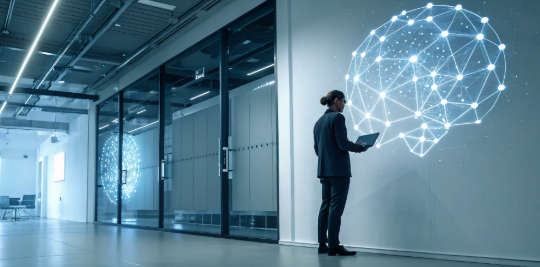You wouldn't build a skyscraper without a detailed blueprint. You’d need to plan the foundation, structure, and systems long before the first steel beam is raised. Building a world-class AI department requires the same level of foresight. Your AI hiring strategy is that blueprint. It outlines how you'll find the right talent, what tools you'll use, and how you'll integrate them to create a strong, scalable team. Without this plan, you risk investing in expensive tools that don't fit your needs or hiring people who aren't aligned with your long-term goals. Expert ai hiring strategy consulting acts as your architect, helping you design a solid plan before you start construction.
Key Takeaways
- Build a Strategy Before You Buy a Tool: A successful AI hiring process isn't about a single piece of software. It's a complete plan that requires a technically literate team, a clean data infrastructure, and clear goals that align with your business.
- Use AI as a Co-pilot, Not the Pilot: Let AI handle the heavy lifting like screening resumes and sourcing candidates at scale. This frees up your recruiters to focus on the irreplaceable human elements: assessing cultural fit, building relationships, and making the final, nuanced hiring decision.
- Measure, Adapt, and Evolve Your Approach: An AI hiring strategy is a living document, not a one-time setup. Define your success metrics upfront, create a clear implementation roadmap, and regularly review your performance to refine your process and stay ahead in a competitive talent market.
What is an AI Hiring Strategy?
An AI hiring strategy is much more than just plugging a new tool into your existing process. It’s a comprehensive plan for how your business will find, attract, and hire the right people using artificial intelligence. A solid strategy ensures that your AI initiatives are directly tied to your company's larger goals, helping you build a team that can drive innovation and growth. It’s about thoughtfully integrating AI to make your recruitment process smarter, faster, and more effective from start to finish. When done right, it creates a clear advantage in a competitive market.
This means looking at the entire talent lifecycle. You’ll define the exact skills you need, particularly in specialized fields like AI and Machine Learning, and then use AI to identify candidates who have them. The goal is to create a seamless, intelligent system that not only fills open roles but also builds a sustainable pipeline of top-tier talent. Developing the right hiring solutions requires a clear vision for how technology can support your human recruiters, freeing them up to focus on what they do best: building relationships and making great hires. It’s the difference between simply using AI and strategically leveraging it to build the future of your company.
How AI is Changing Recruitment
AI is fundamentally reshaping how companies find talent. It takes on the heavy lifting of recruitment, like sifting through hundreds of resumes and sourcing potential candidates from vast online talent pools. Instead of spending hours on manual screening, recruiters can use AI to quickly identify a shortlist of qualified individuals. These tools are becoming incredibly sophisticated, learning from past hiring decisions to get better at spotting the signals of a top-tier candidate. This automation frees up your team to focus on more strategic work, like engaging with candidates, assessing cultural fit, and selling your company’s vision. It’s about augmenting human expertise, not replacing it.
What Makes an AI Hiring Process Work?
A successful AI hiring process is one you can measure. To know if your strategy is effective, you need to track the right data. Key metrics like time-to-fill, cost-per-hire, and quality of hire tell a clear story about your performance. By tracking where your best applicants come from and monitoring diversity metrics, you can make sure your process is both efficient and equitable. Using AI-powered dashboards gives you a real-time view of these key performance indicators, allowing you to make data-driven decisions instead of relying on gut feelings. This analytical approach helps you optimize your resources and continuously improve your hiring outcomes.
Debunking Common Myths About AI in Hiring
Let’s clear up a couple of common misconceptions. First, AI is not here to replace recruiters. It’s a powerful assistant that handles repetitive, high-volume tasks so your hiring team can focus on the human elements of their job. Think of it as a tool that gives them superpowers, helping them find the best people faster. Second, while AI can help reduce human error, it isn't automatically free of bias. An AI algorithm is only as good as the data it learns from. If your historical hiring data contains biases, the AI can inadvertently learn and repeat them. That’s why it’s so important to implement AI thoughtfully and with human oversight.
Key Skills for Your AI Hiring Team
Building a world-class AI department starts with your internal hiring team. Finding top-tier AI talent isn’t a standard HR task; it requires a specialized group of people who can speak the language of AI, manage a complex process, and strategically attract the best candidates. Think of your AI hiring team as the foundational layer of your entire AI strategy. Without the right people leading the charge, you’ll struggle to identify and secure the experts you need to drive innovation.
This isn't about finding one unicorn recruiter who embodies every skill. It's about assembling a team where these competencies are present and work in harmony. Your team must possess a unique blend of technical literacy, project management discipline, recruiting savvy, and analytical skills to succeed. When these four pillars are strong, your hiring process transforms from a reactive necessity into a proactive, strategic advantage. It allows you to not only fill open roles but also to build a sustainable talent pipeline that will support your company’s growth for years to come. A team with this expertise can accurately assess technical depth, run an efficient and positive candidate experience, find hidden talent pools, and use data to continuously improve their approach. Let's look at what each of these core skills involves.
The Right Technical Skills
Your hiring team needs a solid technical foundation to be effective. While they don’t need to be able to build a neural network from scratch, they must have enough technical know-how to understand and guide the hiring process for complex roles. This hybrid skill set allows them to communicate effectively with both your internal AI Engineering teams and business stakeholders. When your recruiters understand the difference between TensorFlow and PyTorch or can discuss the nuances of natural language processing, they can ask insightful questions, properly vet candidates, and gain the respect of the technical experts they’re trying to hire. This technical literacy is the key to separating genuine talent from candidates who just list buzzwords on their resumes.
Project Management and Consulting Expertise
Hiring for an AI role is a project in itself, and it requires strong project management skills to see it through from start to finish. Your team must be able to oversee the entire initiative, from defining the role’s requirements to coordinating interviews and successfully onboarding the new hire. This involves managing timelines, communicating with different departments, and ensuring a seamless experience for every candidate. Beyond logistics, your team should also act as internal consultants. They can provide valuable hiring solutions by advising leadership on market trends, competitive compensation, and the best strategies for attracting the specific talent your projects require. This turns your hiring team from a support function into a strategic partner.
A Deep Grasp of Talent Acquisition
The market for AI talent is incredibly competitive, and standard recruiting methods often fall short. Your hiring team needs a deep understanding of talent acquisition strategies tailored specifically to the AI industry. This isn’t just about posting a job opening and waiting for applications to roll in; it’s about proactively sourcing passive candidates, building talent communities, and knowing exactly where to find professionals with niche skills. A successful team understands the unique landscape of the AI job market, including what motivates top candidates beyond salary, like interesting projects, opportunities for growth, and a strong engineering culture. This specialized knowledge is essential for building a pipeline of qualified candidates and closing offers.
Strong Data Analysis Skills
In a field driven by data, your hiring process should be too. Strong data analysis skills are crucial for your team to make informed, strategic decisions and overcome challenges like skill scarcity. By tracking and analyzing recruitment metrics, your team can identify which sourcing channels deliver the best candidates, how long it takes to fill a role, and where bottlenecks are in your process. This data-driven approach allows you to refine your strategy over time, ensuring you’re investing resources effectively. It also helps in evaluating candidates more objectively and understanding the specific needs of your Data Science & Analytics teams, leading to smarter hiring outcomes and a stronger overall organization.
Why Use AI in Your Hiring Process?
Integrating AI into your hiring process is more than just a tech upgrade; it’s a strategic move that can redefine how you find and attract top talent. When you think about building a world-class team, especially in competitive fields like AI and data science, every advantage counts. Using AI helps you work faster, make smarter choices, and create a better experience for everyone involved. It allows your recruitment team to shift their focus from tedious administrative work to the human side of hiring: building relationships with exceptional candidates. Let’s look at the specific benefits you can expect.
Hire Faster and Reduce Costs
Think about the hours your team spends sifting through hundreds of resumes for a single open role. It’s a time-consuming and often repetitive task. AI tools can automate this initial screening, analyzing applications against your job criteria in seconds. This speed is a game-changer. By shortening the time-to-hire, you not only get critical roles filled faster but also significantly reduce your cost-per-hire. Companies are already seeing great results from using AI in recruitment. This efficiency frees up your recruiters to concentrate on high-value activities, like interviewing promising candidates and making offers, which is a core part of our hiring solutions.
Find Better Candidates and Improve Their Experience
A limited talent pool can lead to a compromised hire. AI helps you cast a wider net, identifying passive candidates who have the right skills but aren’t actively searching on job boards. It can screen many more candidates than a human team ever could, presenting you with a stronger, more qualified shortlist. At the same time, AI improves the applicant's journey. A bad experience can make great candidates turn down job offers. AI-powered chatbots can provide instant application updates and answer common questions 24/7, keeping candidates engaged and informed. This creates a professional and responsive process that reflects well on your brand, which is essential when competing for top AI engineering talent.
Make Smarter Decisions with Data
Hiring decisions have traditionally relied on a mix of experience and gut instinct. AI introduces a powerful layer of data-driven objectivity to the process. Instead of just scanning for keywords, AI uses large amounts of data to quickly find the most suitable people for a job by identifying patterns that correlate with on-the-job success. It can assess technical skills, project experience, and other qualifications with a level of detail that’s difficult to achieve manually. This ensures your decisions are based on concrete evidence, not unconscious bias. By focusing on the data, you can build a more effective team of specialists in areas like data science and analytics.
Support Your Diversity and Inclusion Goals
Building a diverse team is a critical goal for innovative companies, but unconscious bias can unintentionally get in the way. When implemented thoughtfully, AI can be a powerful tool for promoting fairness. AI platforms can be configured to "blind" resumes by hiding demographic information like names, gender, and graduation years during the initial screening. This forces the evaluation to center purely on skills, qualifications, and experience. By standardizing the initial review, you create a more level playing field for all applicants. This approach helps you measure and improve diversity throughout the recruitment process, ensuring you’re building a team with a rich variety of perspectives and backgrounds.
How to Handle the Risks and Ethics of AI Hiring
Using AI in your hiring process comes with incredible advantages, but it also introduces new responsibilities. To build a strategy that’s both effective and ethical, you need to address the potential risks from the very beginning. Thinking through these challenges proactively will help you create a fair, secure, and compliant process that top candidates can trust. It’s not just about finding the right tools; it’s about using them responsibly to build a stronger, more equitable team.
Tackle Algorithmic Bias Head-On
While AI has the potential to reduce human bias, it’s not automatically fair. AI systems learn from the data they’re given, and if that data reflects historical or societal biases, the AI will learn and even amplify them. For example, if past hiring data shows a preference for candidates from certain universities, an AI model might incorrectly learn to favor those schools, overlooking equally qualified talent from elsewhere. To counter this, you must critically evaluate and clean your data sources. Regularly auditing your AI tools for fairness and ensuring they are tested against diverse datasets is essential for building an equitable hiring process.
Protect Candidate Data and Ensure Security
When you use AI in hiring, you’re collecting and processing a significant amount of sensitive candidate data. This creates new security challenges, as AI systems can become targets for cyberattacks. It’s your responsibility to ensure this information is protected. Implementing robust security measures is non-negotiable. This includes everything from data encryption and secure storage to controlling who has access to the AI tools and the information they contain. By prioritizing data security, you not only protect your candidates’ privacy but also build trust in your company’s brand and hiring practices.
Stay on Top of Legal Compliance
The laws and regulations around using AI in employment decisions are changing quickly. Jurisdictions are introducing new rules that govern everything from data privacy to how AI models must be audited for bias. Staying current with these evolving legal frameworks is crucial for avoiding significant legal and financial penalties. Your team needs a clear process for monitoring these developments and ensuring your AI hiring tools and procedures are fully compliant. This isn't a one-time check but an ongoing commitment to responsible and lawful AI implementation in your recruitment efforts.
Keep Humans in the Loop
AI is a powerful assistant, but it shouldn’t be the final decision-maker. The most effective AI hiring strategies use technology to support, not replace, human judgment. AI can efficiently screen thousands of resumes or analyze initial assessments, but the nuanced understanding, empathy, and strategic insight of human recruiters are irreplaceable. Keeping a human in the loop ensures that every candidate is considered holistically and that fairness is maintained throughout the process. This balanced approach combines the scale of AI with the critical thinking of your talent acquisition team, leading to better and more thoughtful hiring outcomes.
How to Build Your AI Hiring Strategy
Creating a successful AI hiring strategy is about more than just buying the latest software. It’s a thoughtful process that weaves together technology, data, and your team’s expertise. When you approach it methodically, you build a system that not only finds great candidates but also supports your company’s long-term goals. Think of it as laying a strong foundation before putting up the walls. A solid strategy ensures every component works together, from the AI tools you choose to the data that powers them. By focusing on these core pillars, you can create a hiring process that is efficient, intelligent, and truly effective. Let’s walk through the key steps to get you there.
Choose the Right AI Technology
With so many AI recruitment tools on the market, it’s easy to get overwhelmed. The key is to focus on your specific needs rather than chasing the newest trend. Start by defining what you want to achieve. Are you looking to source passive candidates more effectively? Do you need to screen high volumes of applications faster? Or is your goal to reduce unconscious bias in the initial review stage?
Once you have clear objectives, you can evaluate which platforms will genuinely help. The best technology should feel like a natural extension of your team, designed to assist recruiters with their most time-consuming tasks. Look for tools that align with your hiring goals and enhance your process without adding unnecessary complexity.
Set Up Your Data Infrastructure
AI runs on data. Without a clean, well-organized data source, even the most advanced AI tool will struggle to deliver meaningful results. Before you implement any new technology, take a look at your current data practices. This is the bedrock of your entire AI strategy. A robust data infrastructure ensures you can effectively collect, store, and analyze information from every stage of the hiring funnel.
This includes everything from past job descriptions and candidate profiles to interview feedback and hiring outcomes. Getting your data house in order is a critical first step. A solid data foundation allows your AI tools to learn from your unique hiring patterns and provide insights that are actually relevant to your organization.
Integrate AI with Your Current Systems
A new AI tool shouldn't create more work for your team. To get the most out of your investment, it needs to integrate smoothly with the systems you already use, like your Applicant Tracking System (ATS) and other HR software. The goal is to create a seamless workflow where information flows freely between platforms, not to build isolated data silos that require manual workarounds.
Think of it as adding a powerful new feature to a system your team already knows and trusts. When AI works in harmony with your existing tech stack, it minimizes disruption and helps your team adopt the new tools more quickly. Proper AI strategy consulting will always prioritize this integration to ensure you see the benefits without the friction.
Train and Develop Your Team
Technology is only half the equation. Your recruiters are the ones who will bring your AI hiring strategy to life, so investing in their development is essential. Your team needs to understand not just how to use the new tools, but also how to interpret the data-driven insights they provide. This goes beyond a simple one-off training session.
Focus on helping your team adapt to new technologies and build new skills, like using predictive analytics to forecast hiring needs or analyzing data to refine sourcing strategies. When you empower your recruiters to become more strategic and data-informed, you ensure your entire organization gets the maximum value from your AI investment. It’s about turning tools into tangible results.
Putting Your AI Hiring Strategy into Action
With a solid plan in place, it's time to bring it to life. Moving from strategy to execution requires a deliberate, step-by-step approach. This is where you’ll translate your goals into concrete actions, get your team aligned, and establish the metrics that will guide your efforts. A great strategy is only as good as its implementation, so focusing on these practical steps is essential for seeing real results. By creating a clear plan, defining success, supporting your team through the change, and tracking your return on investment, you can effectively integrate AI into your hiring process and start attracting the talent your business needs to grow.
Create a Clear Roadmap
Your strategy needs a roadmap to guide you from point A to point B. AI is transforming how businesses operate, and companies without a clear plan for adopting it risk falling behind. A roadmap breaks your high-level strategy into manageable phases with clear timelines, milestones, and assigned responsibilities. It should detail which AI tools you'll implement first, how you'll integrate them, and what resources you'll need. This isn't just a document; it's your operational playbook for turning your vision into reality. By mapping out the journey, you provide clarity for your team and ensure everyone is moving in the same direction toward your hiring goals.
Define What Success Looks Like
You can't improve what you don't measure. Before you launch any new AI tools, you need to define what a successful outcome looks like in clear, quantifiable terms. How will you know your investment is paying off? By establishing key performance indicators (KPIs) from the start. Measuring recruitment metrics gives you the data you need to refine your process and attract top talent. Think about metrics like time-to-fill, cost-per-hire, quality-of-hire, and offer acceptance rate. These numbers will become your benchmarks, allowing you to track progress and demonstrate the value of your new approach to company leadership.
Manage the Transition for Your Team
New technology can be intimidating, and it’s natural for your team to have questions or concerns. The key to a smooth transition is open communication and support. Frame AI not as a replacement for recruiters but as a powerful assistant that automates repetitive tasks, freeing them up to focus on what they do best: building relationships with candidates. It’s important to help your team understand and accept AI, addressing any worries along the way. Provide comprehensive training, create a space for feedback, and celebrate early wins to build momentum. When your team feels confident and supported, they become champions for the change.
Measure Your ROI and Track Performance
Once your AI hiring tools are active, the work isn't over. Continuous monitoring is essential to ensure you’re getting a positive return on your investment (ROI). This means regularly tracking the performance metrics you established earlier. Are you filling roles for specialized positions like Machine Learning Engineers faster? Has your cost-per-hire decreased? Is the quality of your new hires improving? Tracking common recruiting metrics like source-of-hire and application completion rate provides the hard data needed to justify the investment. This information allows you to make informed adjustments, optimize your strategy over time, and prove the impact of AI on your company's bottom line.
How to Future-Proof Your AI Hiring Strategy
The world of AI moves incredibly fast. A hiring strategy that works today might be outdated in six months. To build a team that not only meets your current needs but also drives future innovation, you need a forward-thinking approach. Future-proofing your AI hiring strategy means building a resilient, adaptable plan that can evolve with new technologies and business goals. It’s about shifting from reactive hiring—filling roles as they become vacant—to proactively building the talent pipeline you’ll need for years to come. This strategic foresight ensures you aren't caught off guard by market shifts or new technological breakthroughs.
A future-proof strategy is built on four key pillars. First, you must keep a close watch on new technologies to understand what skills will be in demand tomorrow. Second, you need to plan for growth and scalability, hiring people who can build systems that last. Third, it's essential to create a process for continuous improvement, fostering a culture where both your team and your technology are constantly getting better. Finally, you must be willing to refine your strategy over time, treating it as a dynamic plan rather than a static document. By embracing these principles, you can create a hiring engine that consistently brings in the right talent to keep your company at the forefront of the AI revolution.
Keep an Eye on New Technologies
The AI landscape is in a constant state of flux, and as one report notes, "AI is changing how businesses work very quickly." Companies that fail to adapt risk falling behind. Staying current means more than just reading headlines; it requires a deep understanding of how emerging technologies will impact your business and the skills your team needs. For example, the rise of generative AI has created a demand for new specializations. As you plan your hiring, consider how combining different types of AI, like predictive and generative models, can create more powerful solutions and what kind of talent can bring those ideas to life. Keeping a pulse on the latest developments in Machine Learning ensures you’re always looking for the right skills.
Plan for Growth and Scalability
Your AI initiatives are designed to grow, and your team should be built to support that expansion. It’s not enough to hire for the project you have today; you need to hire for the company you want to be in five years. As your business scales, your AI systems must be able to handle more data, more users, and more complexity. This is why planning for scalability from day one is critical. Look for candidates, particularly in Data Infrastructure & MLOps, who have a proven track record of building robust, scalable systems. These professionals think about the long-term architecture, ensuring that what they build today won't need a complete overhaul tomorrow.
Create a Process for Continuous Improvement
An effective AI model is never truly "finished." It "needs constant watching and adjusting to make sure it keeps working well and meets changing business needs." The same principle applies to your AI team. The best talent in this field is driven by curiosity and a desire to learn. To attract and retain them, you need to build a culture that champions continuous improvement. This means providing opportunities for upskilling, encouraging experimentation, and creating feedback loops that help everyone grow. Your hiring process itself should also be part of this cycle. Regularly analyze your hiring metrics to identify what’s working and where you can make your process more efficient and effective for finding top-tier AI Engineers.
Refine Your Strategy Over Time
A static hiring plan is a losing one. The most successful companies treat their AI hiring strategy as a living document that requires regular attention and adjustment. Set aside time every quarter or twice a year to review your approach. Are the roles you’re hiring for still aligned with your business goals? Are your sourcing methods still effective? Is your interview process identifying the right competencies? The AI talent market is competitive, and what worked last year might not work today. Partnering with a specialized recruitment agency can provide the market intelligence you need to make informed adjustments and refine your hiring solutions to stay ahead of the curve.
Related Articles
Frequently Asked Questions
Will AI make my human recruiters obsolete? Not at all. Think of AI as a powerful assistant, not a replacement. Its real value is in handling the repetitive, high-volume tasks that can bog down a recruiting team, like sifting through hundreds of resumes or sourcing candidates. This frees up your recruiters to focus on the work that truly requires a human touch: building relationships, assessing cultural fit, and acting as strategic advisors to the business. The goal is to combine AI's efficiency with your team's irreplaceable empathy and judgment.
I'm a smaller company. Can I still build an effective AI hiring strategy without a huge budget? Absolutely. An effective strategy isn't about buying the most expensive software; it's about being smart with your approach. You can start by focusing on one specific challenge, like improving the initial screening process for a high-volume role. Begin by clearly defining your goals and ensuring your existing data is clean and organized. Many scalable AI tools are available that don't require a massive enterprise-level investment. The strategy itself—the plan—is what creates the advantage, not the price tag of the technology.
My company's past hiring data might not be perfect. How can I use AI without reinforcing old biases? This is a critical question and a valid concern. The key is to be intentional from the start. You can't simply plug in an AI tool and hope for the best. First, work to clean and audit your historical data to the best of your ability. More importantly, choose AI tools that allow for transparency and can be configured to promote fairness, such as by hiding demographic information to create a "blind" initial review based purely on skills. Always maintain a human-in-the-loop approach, where AI provides a shortlist but your team makes the final, nuanced decisions.
What is the single most important first step to take when building an AI hiring strategy? Before you look at any technology, the most important first step is to define your problem. Sit down with your team and leadership to get specific about what you want to achieve. Are you trying to reduce the time it takes to fill roles? Do you need to find more qualified candidates in a niche field? Are you trying to improve your diversity metrics? Answering this question with absolute clarity will guide every other decision, from the technology you choose to the metrics you track.
How do I get my existing recruiting team on board with using AI? The best way to encourage adoption is to involve your team from the beginning. Frame the change as an investment in their success, not a new system to police their work. Ask for their input on the biggest challenges AI could help solve and include them in the process of evaluating different tools. Provide comprehensive training that focuses on how AI will help them achieve their goals and remove tedious work, and be sure to create an open channel for feedback as they begin using the new systems.















